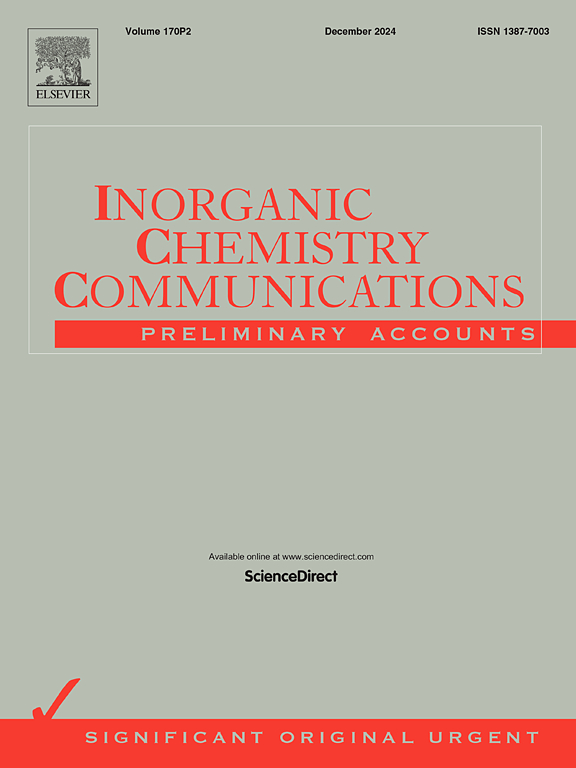Sanchezia nobilis leaves derived N, O co-doped carbon activated by magnesium chloride for enhanced chromium removal
IF 4.4
3区 化学
Q1 CHEMISTRY, INORGANIC & NUCLEAR
引用次数: 0
Abstract
Chromium contamination persists as a pressing environmental issue, prompting ongoing endeavors to devise economical and efficient adsorbents for Cr(VI) eradication. Herein, N, O co-doped carbons (MgBC) were successfully synthesized through a single-step pyrolysis process, employing sanchezia nobilis as the raw material and magnesium chloride as the activator. Characterization results revealed that, under optimal conditions, specifically a biomass-to-activator mass ratio of 1:2 and a carbonization temperature of 600 °C, the MgBC possessed a specific surface area of 267.18 m2 g−1, a nitrogen content of 3.65 at%, and an oxygen content of 8.72 at%. In addition, diverse parameters, encompassing carbonization temperature, activator dosage, initial Cr(VI) concentration, adsorption duration, and solution pH, were systematically investigated to evaluate their impact on the adsorption performance of MgBC for Cr(VI) removal. The optimal MgBC demonstrated rapid kinetics and substantial adsorption capacity, achieving a Langmuir maximum capacity of 27.77 mg g−1 at a solution pH of 7. The superior performance of MgBC can be ascribed to its augmented specific surface area, optimized porosity, and heightened N, O content. The adsorption data adhered well to the pseudo-second-order model and Langmuir model suggested that physical adsorption with monolayer coverage predominated, albeit with some involvement of chemical processes. Additional mechanistic analysis confirmed that the attachment of Cr(VI) to MgBC primarily resulted from a synergistic interaction of electrostatic attraction, surface complexation and reduction. This work not only proposes a new approach for the development of heavy metal adsorbents, but also provides theoretical support for environmental remediation strategies.

用氯化镁活化三叶草叶片制备N, O共掺杂碳以增强除铬性能
铬污染一直是一个紧迫的环境问题,促使人们不断努力设计经济高效的Cr(VI)清除吸附剂。本文以硝酸三子为原料,氯化镁为活化剂,通过一步热解法成功合成了N, O共掺杂碳(MgBC)。表征结果表明,在最佳条件下,即生物质与活化剂的质量比为1:2,炭化温度为600℃,MgBC的比表面积为267.18 m2 g−1,氮含量为3.65 at%,氧含量为8.72 at%。此外,系统地研究了碳化温度、活化剂用量、初始Cr(VI)浓度、吸附时间和溶液pH等不同参数对MgBC去除Cr(VI)吸附性能的影响。最佳MgBC表现出快速的吸附动力学和可观的吸附容量,在溶液pH为7时,Langmuir最大吸附容量为27.77 mg g−1。MgBC的优异性能可归因于其增加的比表面积,优化的孔隙率和提高的N, O含量。吸附数据很好地符合拟二阶模型和Langmuir模型,表明以单层覆盖的物理吸附为主,尽管有一些化学过程的参与。进一步的机理分析证实,Cr(VI)在MgBC上的附着主要是由于静电吸引、表面络合和还原的协同作用。这项工作不仅为重金属吸附剂的开发提供了新的途径,也为环境修复策略提供了理论支持。
本文章由计算机程序翻译,如有差异,请以英文原文为准。
求助全文
约1分钟内获得全文
求助全文
来源期刊

Inorganic Chemistry Communications
化学-无机化学与核化学
CiteScore
5.50
自引率
7.90%
发文量
1013
审稿时长
53 days
期刊介绍:
Launched in January 1998, Inorganic Chemistry Communications is an international journal dedicated to the rapid publication of short communications in the major areas of inorganic, organometallic and supramolecular chemistry. Topics include synthetic and reaction chemistry, kinetics and mechanisms of reactions, bioinorganic chemistry, photochemistry and the use of metal and organometallic compounds in stoichiometric and catalytic synthesis or organic compounds.
 求助内容:
求助内容: 应助结果提醒方式:
应助结果提醒方式:


